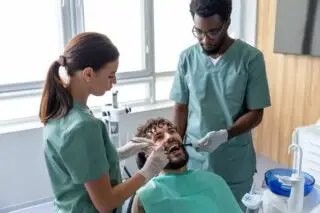When we sense danger, we instinctually experience fear. Fear triggers our body to prepare to defend ourselves against or evade from the danger. This so-called “fight-or-flight” response is a natural reaction meant to protect us. However, in people who suffer from post-traumatic stress disorder (PTSD), this response has been altered in a way that they experience fear or stress even if they’re no longer in danger. Click Image To Enlarge
What is PTSD?
PTSD is a mental health condition that develops after a person experienced or witnessed a terrifying event. While many people have difficulty adjusting and coping for a while after a traumatic event, they normally get better with time and don’t develop PTSD. Yet, some people show symptoms of PTSD like flashbacks, nightmares, anxiety and frightening thoughts that get worse and/or last for months or even years, severely interfering with their daily lives.
Who suffers from PTSD?
Whereas PTSD first became known to the public in relation to war veterans who were unable to fully recover from the horrors they experienced or witnessed in war, the condition can also be triggered by various other traumatic events. Examples include mugging, assault, rape, torture, child abuse, kidnapping, captivity, car accidents, train wrecks, plane crashes, bombings or natural disasters like floods and earthquakes. It is estimated that almost 260 million people worldwide suffered from PTSD in the last year. In the U.S., about 3.5% of adults are being diagnosed with PTSD in any given year. The median age for the onset of the condition is 23. The disorder seems to be more prevalent among women than men. Out of the 60% of women who experience at least one traumatic event in their lifetime, about 20% develop PTSD. In comparison, out of the 50% of men who undergo at least one traumatic incident in their life, approximately 8% develop PTSD.
PTSD in children
Even more disconcerting, more than 60% of children between the ages 0-17 and 47% of adolescents between the ages 12-17 experienced or witnessed at least one traumatic event in 2008 alone. Almost half of these children experienced physical assault, a quarter witnessed violence, a tenth suffered from maltreatment and 6% of sexual victimization. It is estimated that about 5% of these children meet the criteria for PTSD. Again, girls seem to be more susceptible to PTSD than boys, with 8% of the former and 2% of the latter showing symptoms of the disorder. More than a fifth of children raised in foster care are diagnosed with PTSD, mainly triggered by sexual or physical abuse.
PTSD in the military
Unsurprisingly, PTSD is very common in the military. More than a quarter of U.S. veterans who fought in the War on Terror were diagnosed and treated for the disorder by the Veterans Health Administration between the years 2004 and 2009 alone. Half of the suicides among active duty service members in 2010 were committed by those who fought in the War on Terror. The disorder is most prevalent among those who fought in the Vietnam War, with 30% of combat service veterans suffering from PTSD. In addition, 10% of Gulf War, 6-11% of Afghanistan and 12-20% of Iraq combatant service veterans were diagnosed with PTSD.
PTSD and domestic abuse
PTSD is also strongly related to domestic abuse. While 25% of women will experience domestic abuse in their lifetime, 8% of men will be physically or sexually abused by their significant other. In total, 85% of domestic violence victims are women. The risk for developing PTSD after experiencing domestic violence is highest among those who suffered through rape (49%), physical assault (32%) and sexual assault (24%).
What to do if you or someone you know has PTSD
In general, early intervention after trauma is key to preventing the development of PTSD. For instance, early intervention can lower the risk of developing PTSD in children by 73 percent. If you or someone you know with PTSD is in crisis or at risk of self-harm you should immediately do one of the following:
- Call 9-1-1
- Go to the nearest emergency room
- Call the Suicide Prevention Lifeline: 1-800-273-8255
- For military/veterans – call the Veterans Combat Call Center: 1-877-927-8387



